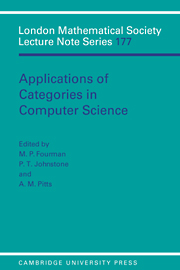 Applications of Categories in Computer Science
Applications of Categories in Computer Science Book contents
- Frontmatter
- Contents
- Preface
- Miscellaneous Frontmatter
- Computational comonads and intensional semantics
- Weakly distributive categories
- Sequentiality and full abstraction
- Remarks on algebraically compact categories
- Dinaturality for free
- Simply typed and untyped lambda calculus revisited
- Modelling reduction in confluent categories
- On clubs and data-type constructors
- Penrose diagrams and 2-dimensional rewriting
- Strong monads, algebras and fixed points
- Semantics of local variables
- Using fibrations to understand subtypes
- Reasoning about sequential functions via logical relations
- I-categories and duality
- Geometric theories and databases
- Partial products, bagdomains and hyperlocal toposes
Remarks on algebraically compact categories
Published online by Cambridge University Press: 24 September 2009
- Frontmatter
- Contents
- Preface
- Miscellaneous Frontmatter
- Computational comonads and intensional semantics
- Weakly distributive categories
- Sequentiality and full abstraction
- Remarks on algebraically compact categories
- Dinaturality for free
- Simply typed and untyped lambda calculus revisited
- Modelling reduction in confluent categories
- On clubs and data-type constructors
- Penrose diagrams and 2-dimensional rewriting
- Strong monads, algebras and fixed points
- Semantics of local variables
- Using fibrations to understand subtypes
- Reasoning about sequential functions via logical relations
- I-categories and duality
- Geometric theories and databases
- Partial products, bagdomains and hyperlocal toposes
Summary
In Algebraically Complete Categories (in the proceedings of the Category theory conference in Como '90) an ALGEBRAICALLY COMPLETE CATEGORY was defined as one for which every covariant endofunctor has an initial algebra. This should be understood to be in a 2-category setting, that is, in a setting in which the phrase “every covariant endofunctor” refers to an understood class of endofunctors.
Given an endofunctor T the category of T- INVARIANT objects is best defined as the category whose objects are triples <A,f, g> where f:TA →A, g:A→TA and fg and gf are both identity maps. T-Inv appears as a full subcategory of both T-Alg and T-Coalg, in each case via a forgetful functor. The Lambek lemma and its dual say that the initial object in T-Alg and the final object in T-Coalg may be viewed as objects in T-Inv wherein they easily remain initial and final. Of course there is a canonical map from the initial to the final. I will say that T is ALGEBRAICALLY BOUNDED if this canonical map is an isomorphism, equivalently if T-Inv is a punctuated category, that is one with a biterminator, an object that is both initial and final.
An algebraically bicomplete category is ALGEBRAICALLY COMPACT if each endofunctor is algebraically bounded. (As with algebraic completeness this should be understood to be in a 2-category setting.) In this context I will use the term FREE T-ALGEBRA rather than either initial algebra or final coalgebra.
- Type
- Chapter
- Information
- Applications of Categories in Computer ScienceProceedings of the London Mathematical Society Symposium, Durham 1991, pp. 95 - 106Publisher: Cambridge University PressPrint publication year: 1992
- 23
- Cited by


